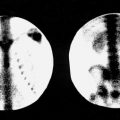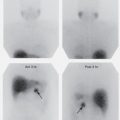Pregnancy
Many clinicians are concerned about ordering radionuclide scans for a pregnant patient. The question most frequently arises in connection with lung and hepatobiliary scans. In general, if the scan is medically indicated and would be performed on a nonpregnant female, it is indicated during pregnancy. There are some facts to be kept in mind when considering this issue:
- 1.
Radiation-induced fetal abnormalities have not been reported at fetal absorbed dose levels below 10 rads (0.1 Gy). The risk of spontaneous congenital abnormalities is between 3% and 6%.
- 2.
The risk of radiation carcinogenesis may be higher for the embryo/fetus and children than for adults, but the risk is not likely to exceed 1 in 1000 per rad (10 mGy). The spontaneous cancer risk in the United States is about 1 in 3 (33%).
- 3.
Iodine will cross the placenta. The fetal thyroid does not concentrate iodine before about 12 weeks’ gestational age. After this, the fetal thyroid will avidly accumulate iodine, which can be blocked by administering stable iodine (potassium iodide, 130 mg) to the mother.
- 4.
It is unlikely that the fetal absorbed dose from xenon-133 ( 133 Xe) or technetium-99m ( 99m Tc) radiopharmaceuticals (other than mercaptoacetyltriglycine [MAG3], sestamibi, or pertechnetate) would exceed 0.5 rad (5 mGy). See Table G.1 .
TABLE G.1
Estimated Absorbed Dose to Embryo/Fetus for Selected Radiopharmaceuticals for Different Stages of Pregnancy a
Radiopharmaceutical
Early
(mGy/MBq)
3 Month
(mGy/MBq)
6 Month
(mGy/MBq)
9 Month
(mGy/MBq)
18 F-FDG b
2.5 × 10 -2
1.3 × 10 -2
8.5 × 10 -3
5.1 × 10 -3
18 F-Na Fluoride
2.2 × 10 -2
1.7 × 10 -2
7.5 × 10 -3
6.8 × 10 -3
67 Ga-Citrate b
9.3 × 10 -2
2.0 × 10 -1
1.8 × 10 -1
1.3 × 10 -1
99m Tc-Disofenin
1.7 × 10 -2
1.5 × 10 -2
1.2 × 10 -2
6.7 × 10 -3
99m Tc-DMSA b
5.1 × 10 -3
4.7 × 10 -3
4.0 × 10 -3
3.4 × 10 -3
99m Tc-DTPA b
1.2 × 10 -2
8.7 × 10 -3
4.1 × 10 -3
4.7 × 10 -3
99m Tc-DTPA (aerosol) b
5.8 × 10 -3
4.3 × 10 -3
2.3 × 10 -3
3.0 × 10 -3
99m Tc-Glucoheptonate b
1.2 × 10 -2
1.1 × 10 -2
5.3 × 10 -3
4.6 × 10 -3
99m Tc-HMPAO
8.7 × 10 -3
6.7 × 10 -3
4.8 × 10 -3
3.6 × 10 -3
99m Tc-MAA
2.8 × 10 -3
4.0 × 10 -3
5.0 × 10 -3
4.0 × 10 -3
99m Tc-MAG3
1.8 × 10 -2
1.4 × 10 -2
5.5 × 10 -3
5.2 × 10 -3
99m Tc-MDP b
6.1 × 10 -3
5.4 × 10 -3
2.7 × 10 -3
2.4 × 10 -3
99m Tc-MIBI–rest
1.5 × 10 -2
1.2 × 10 -2
8.4 × 10 -3
5.4 × 10 -3
99m Tc-MIBI–stress
1.2 × 10 -2
9.5 × 10 -3
6.9 × 10 -3
4.4 × 10 -3
99m Tc-Pertechnetate b
1.1 × 10 -2
2.2 × 10 -2
1.4 × 10 -2
9.3 × 10 -3
99m Tc-RBC in vitro b
6.8 × 10 -3
4.7 × 10 -3
3.4 × 10 -3
2.8 × 10 -3
99m Tc-RBC in vivo b
6.4 × 10 -3
4.3 × 10 -3
3.3 × 10 -3
2.7 × 10 -3
99m Tc-Sulfur colloid b
1.8 × 10 -3
2.1 × 10 -3
3.2 × 10 -3
3.7 × 10 -3
99m Tc-leukocytes
3.8 × 10 -3
2.8 × 10 -3
2.9 × 10 -3
2.8 × 10 -3
123 I Na-iodide b
2.0 × 10 -2
1.4 × 10 -2
1.1 × 10 -2
9.8 × 10 -3
131 I Na-iodide b
7.2 × 10 -2
6.8 × 10 -2
2.3 × 10 -1
2.7 × 10 -1
133 Xe gas c
2.2 × 10 -4
2.6 × 10 -5
1.9 × 10 -5
1.5 × 10 -5 
Stay updated, free articles. Join our Telegram channel

Full access? Get Clinical Tree






